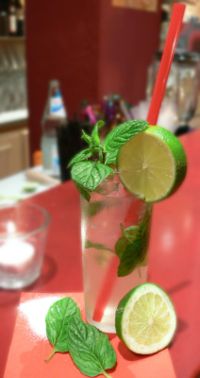Mojito: Difference between revisions
Undid revision 142484028 by 69.139.185.56 (talk) |
No edit summary |
||
| Line 20: | Line 20: | ||
<references/> |
<references/> |
||
==External |
==External Links== |
||
*[http://www.cocktailteam.net/default.aspx CocktailTeam.net] |
|||
*[http://www.tasteofcuba.com/mojito.html Traditional Mojito recipe from Cuba] |
*[http://www.tasteofcuba.com/mojito.html Traditional Mojito recipe from Cuba] |
||
*[http://www.simplestupid.com/recipe.htm?id=73 Mojito Recipe] |
*[http://www.simplestupid.com/recipe.htm?id=73 Mojito Recipe] |
||
Revision as of 19:22, 4 July 2007

Mojito (pronounced IPA: [məˈhiː.toʊ] Transclusion error: {{En}} is only for use in File namespace. Use {{langx|en}} or {{in lang|en}} instead. [mo'xi.to] Template:Es) is a traditional Cuban cocktail which became popular in the United States during the late 1980s, and has recently seen a resurgence in popularity.
A mojito is traditionally made of five ingredients: spearmint, rum, sugar (traditionally sugar cane juice), lime, and carbonated water. Its combination of sweetness and refreshing citrus and spearmint flavors are intended to mask the potent kick of the rum, and have made this clear cocktail a popular summer drink.
To make a Mojito, juice from a lime is added to sugar and mint leaves in a tall glass. The mixture is then mashed repeatedly with a muddler. Crushed ice is then added, followed by rum and topped off with club soda.
Its popularity is evidenced by its prominent role in recent Bacardi advertisements. After the daiquiri (another rum-based cocktail), the mojito was the second favorite drink of the writer Ernest Hemingway.[1]. It is rumored that the origin of the word "mojito" is derived from the diminutive of the word mojo.
See also
References
- ^ Newman, "Direct from Havana", Art Culinaire, summer 2004
